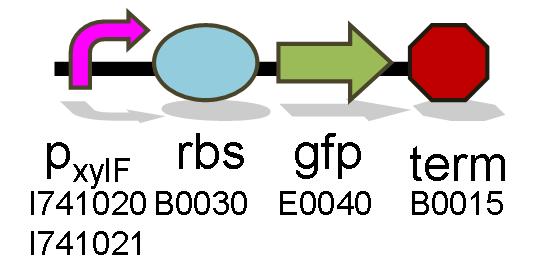PennState/Project/Diauxie/PromoterTest
From 2007.igem.org
Mnmarshall (Talk | contribs) |
Mnmarshall (Talk | contribs) |
||
| Line 13: | Line 13: | ||
| - | After each of the four promoter constructs are tested individually, the two which include the CRP-cAMP are changed so that a gene expressing the mutant CRP* is included. This would act as an effective increase the CRP-cAMP levels in the cell, increasing the strength of the promoter through positive feedback. | + | After each of the four promoter constructs are tested individually, the two which include the CRP-cAMP are changed so that a gene expressing the mutant CRP* is included. This would act as an effective increase in the CRP-cAMP levels in the cell, increasing the strength of the promoter through positive feedback. |
<html><img src="http://openwetware.org/images/9/99/Pctestcrp.jpg" id="logo" name="logo" height="150" width="420" alt="" /></html> | <html><img src="http://openwetware.org/images/9/99/Pctestcrp.jpg" id="logo" name="logo" height="150" width="420" alt="" /></html> | ||
Latest revision as of 03:05, 27 October 2007
Promoter Test Constructs
The xyl bidirectional promoter region promotes in the direction of the genes encoding for xylAB and xylFGH metabolization and transport proteins. The CPR-cAMP, and xylR binding sites regulate both directions. This means that there are four possibilities for making promoters: xylF facing including the CRP-cAMP binding site, xylF facing without the CRP-cAMP binding site, xylA facing including the CRP-cAMP binding site, and xylA facing without the CRP-cAMP binding site.
To test the four xyl promoters, each is placed in a construct followed by a ribosome binding site, the reporter green florescent protein, and a terminator. The strength of each is measured by gfp emission.
 This construct uses the xylF and xylA facing promoters that include the CRP-cAMP binding region.
This construct uses the xylF and xylA facing promoters that include the CRP-cAMP binding region.
 This construct uses the xylF and xylA facing promoters that do not include the CRP-cAMP binding region.
This construct uses the xylF and xylA facing promoters that do not include the CRP-cAMP binding region.
After each of the four promoter constructs are tested individually, the two which include the CRP-cAMP are changed so that a gene expressing the mutant CRP* is included. This would act as an effective increase in the CRP-cAMP levels in the cell, increasing the strength of the promoter through positive feedback.

This construct uses the xylF and xylA facing promoters that include the CRP-cAMP binding region followed by the CRP* gene.